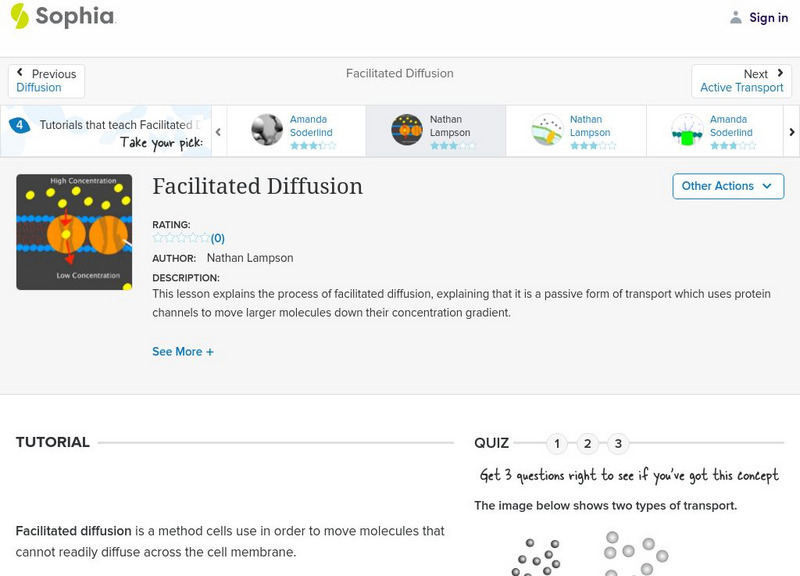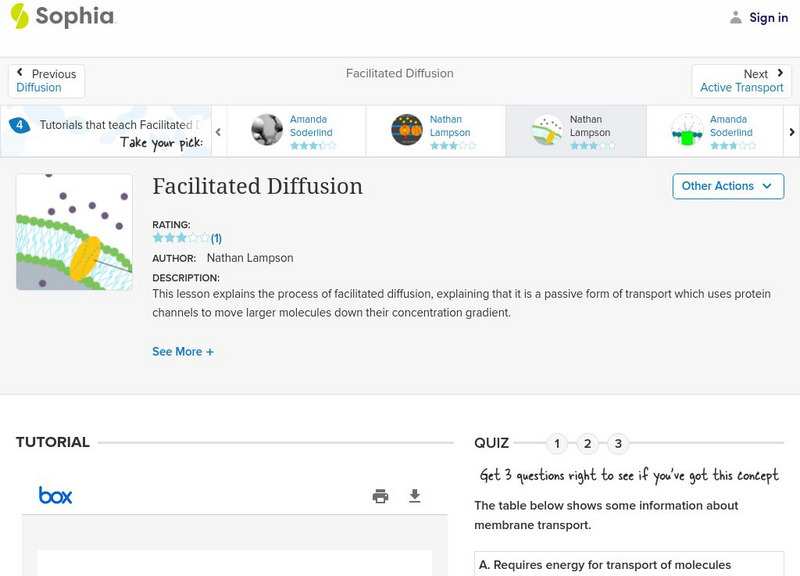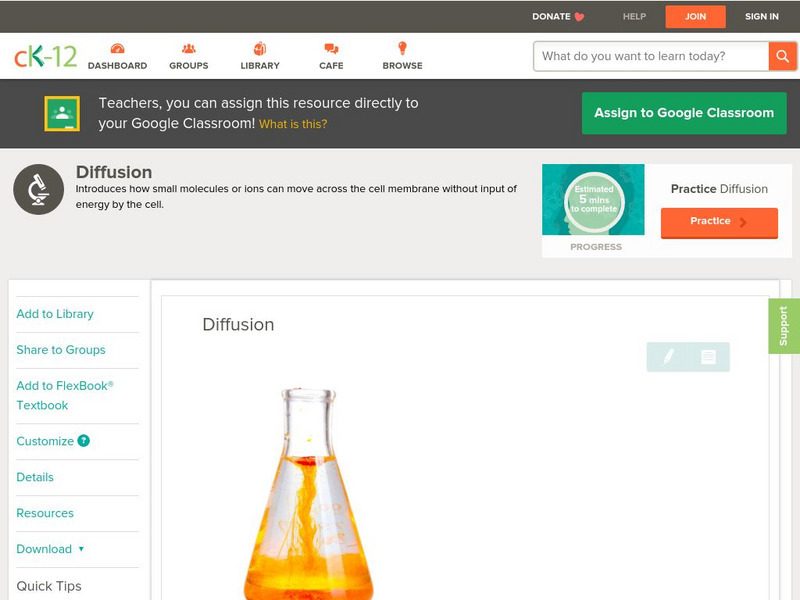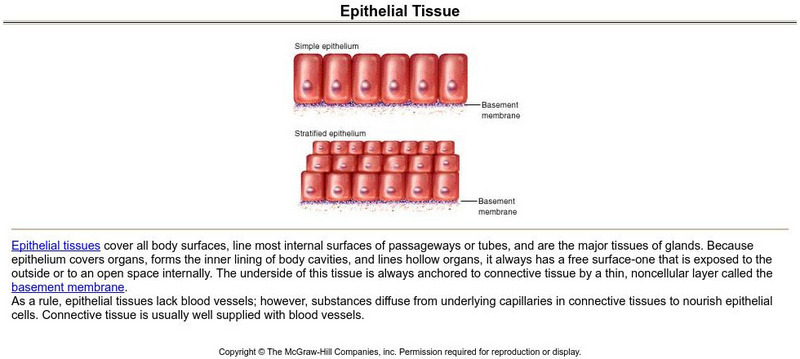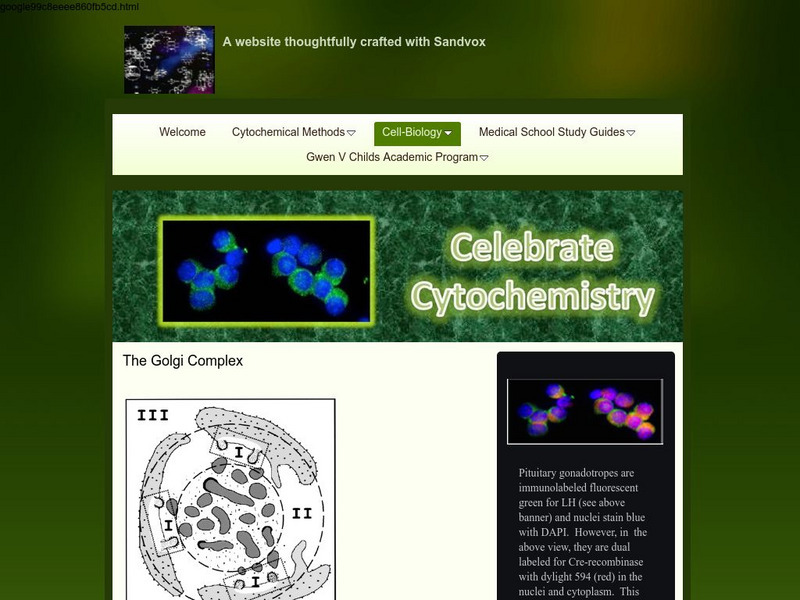Cosmo Learning
Cosmo Learning: Video: Blood Grouping
A video that explores the different blood types and what distinguishes the different types. Learn that the ABO blood types are defined by the absence or presence of two major proteins that are found in the red blood cells membrane. Video...
Sophia Learning
Sophia: Facilitated Diffusion: Lesson 3
This lesson explains the process of facilitated diffusion, explaining that it is a passive form of transport which uses protein channels to move larger molecules down their concentration gradient. It is 3 of 9 in the series titled...
Sophia Learning
Sophia: Facilitated Diffusion: Lesson 4
This lesson explains the process of facilitated diffusion, explaining that it is a passive form of transport which uses protein channels to move larger molecules down their concentration gradient. It is 4 of 9 in the series titled...
Sophia Learning
Sophia: Facilitated Diffusion: Lesson 5
This lesson explains the process of facilitated diffusion, explaining that it is a passive form of transport which uses protein channels to move larger molecules down their concentration gradient. It is 5 of 9 in the series titled...
Sophia Learning
Sophia: Facilitated Diffusion: Lesson 1
This lesson explains the process of facilitated diffusion, explaining that it is a passive form of transport which uses protein channels to move larger molecules down their concentration gradient. It is 1 of 9 in the series titled...
PBS
Pbs Learning Media: Journey Into Dna
Travel deep into the human body to see exactly where your DNA resides. From the NOVA: Cracking the Code of Life Web site.
Alabama Learning Exchange
Alex: Rubber Egg Diffusion
This lab will illustrate diffusion and osmosis through a semi-permeable membrane. A chicken egg will be used as the model cell, because the yolk is actually a single large cell. The surrounding egg white, or albumin, contains water and...
CK-12 Foundation
Ck 12: Biology: Prokaryote Structure
[Free Registration/Login may be required to access all resource tools.] Covers the common shapes and features of prokaryotic cells.
Other
Society for General Microbiology: Bacteria
Bacteria are single celled microbes. The cell structure is simpler than that of other organisms as there is no nucleus or membrane bound organelles. Instead their control centre containing the genetic information is contained in a single...
CK-12 Foundation
Ck 12: Life Science: Archaea
[Free Registration/Login may be required to access all resource tools.] For many years, archaea were classified as bacteria. Like the bacteria, archaea lacked a nucleus and membrane-bound organelles and, therefore, were prokaryotic...
CK-12 Foundation
Ck 12: Life Science: Diffusion
[Free Registration/Login may be required to access all resource tools.] The process of molecules moving from an area where there are lots of molecules to an area where there are fewer molecules is known as diffusion. The diffusion of...
Chem4kids
Chem4 Kids: Acids in Proteins
The first thing you might be asking is, "What is an amino acid?" There are more than fifty, and each one of them is a little different. Amino acids are used in every cell of your body to build the proteins you need to survive. All...
City University of New York
Brooklyn College: Osmosis Interactive Activity
Great activity with clear background information. Try out the lab using osmosis to calculate molecular weight.
University of Washington
Our Chemical Senses: Olfaction Experiments
This website provides information on our chemical senses. "Students learn how to investigate the olfactory system and then find out how to plan and carry out their own experiments."
McGraw Hill
Glencoe Biology: Cellular Transport: Self Check Quiz
Answer five multiple-choice quiz questions about the different types of cellular transport.
Sophia Learning
Sophia: Passive Transport: Lesson 2
This lesson introduces the process of passive transport, explaining that it is a form of transport that does not require energy, and moves molecules down their concentration gradient. It is 2 of 4 in the series titled "Passive Transport."
Khan Academy
Khan Academy: Biosignaling Questions
Practice for the MCAT with these questions about biosignaling.
Khan Academy
Khan Academy: Osmosis and Tonicity
Provides an overview of osmosis and tonicity and looks at how osmosis works, as well as the role it plays in the water balance of cells. Describes hypertonic, isotonic, and hypotonic solutions and their effect on cells.
McGraw Hill
Mc Graw Hill: Epithelial Tissue
The structure and function of epithelial tissues and basements membranes are explained in this concise site.
BiologyWise
Biology Wise: The Characteristics and Uses of Isotonic Solution
Discusses the importance of isotonicity to cell survival and some different uses of isotonic solutions, particularly in medicine.
Khan Academy
Khan Academy: Ion Transport Defects Cause Cystic Fibrosis
Practice for the MCAT with these questions about Cystic Fibrosis.
Khan Academy
Khan Academy: Neuron Action Potentials: The Creation of a Brain Signal
Explains how neurons work during the formation and transmission of brain signals.
Khan Academy
Khan Academy: Action Potential Velocity
Brain cells called neurons send information and instructions throughout the brain and body. The information is sent via electro-chemical signals known as action potentials that travel down the length of the neuron. These neurons are then...
Other
Golgi Complex: Structure and Function
How do proteins move to the Golgi Complex? What types of secretion are controlled by the Golgi complex? How does Golgi complex regulate the insertion of plasma membrane proteins? Can proteins be transported back to the rough endoplasmic...
Other popular searches
- Analogies for Cell Membrane
- Cell Membrane Egg Vinegar
- Cell Membrane Transport
- Cell Membrane Structure
- Cell Membrane Pictures
- Cell Membrane Model
- Bubbles Cell Membrane
- Cell Membrane Permeability
- Permeable Cell Membranes
- Cell Membrane and Diffusion
- Cell Membrane Lesson Plan
- Cell Membranes and Transport

